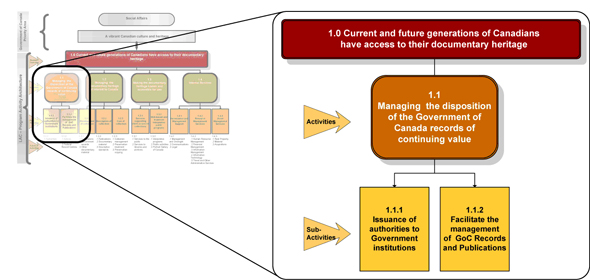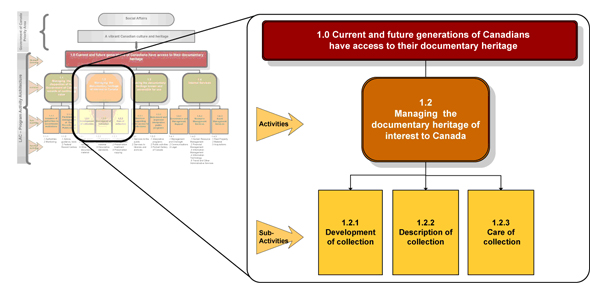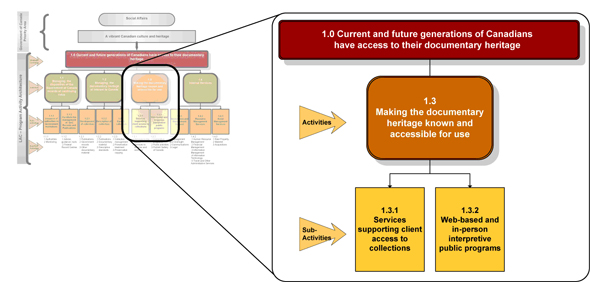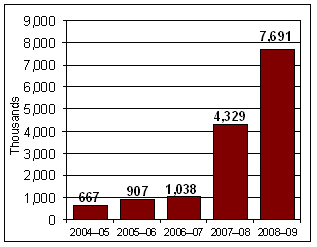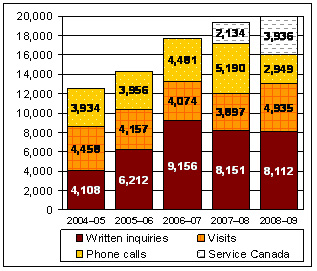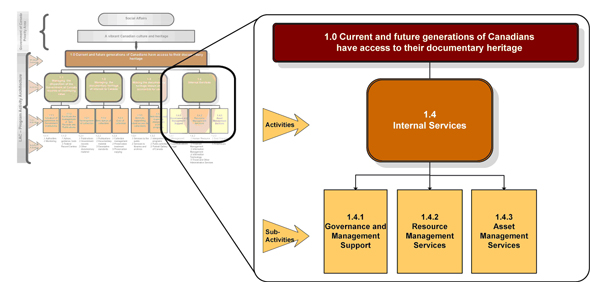Common menu bar links
Breadcrumb Trail
ARCHIVED - Library and Archives Canada
 This page has been archived.
This page has been archived.
Archived Content
Information identified as archived on the Web is for reference, research or recordkeeping purposes. It has not been altered or updated after the date of archiving. Web pages that are archived on the Web are not subject to the Government of Canada Web Standards. As per the Communications Policy of the Government of Canada, you can request alternate formats on the "Contact Us" page.
Section II – Analysis of Program Activities by Strategic Outcome
This section presents the LAC program activities under our single strategic outcome as well as the results we achieved in 2008–2009. It shows the resources that LAC spent for each program activity and describes the institution's performance in relation to the Major Areas of Attention that were set out in the Report on Plans and Priorities. It also describes benefits for Canadians, analyzes performance and indicates lessons learned.
Current and future generations of Canadians have access to their
documentary heritage
This single strategic outcome focuses all Library and Archives Canada strategies, actions and resource uses. It is supported through work under three operational program activities plus an internal services program activity.
For this report, LAC reports in two complementary manners.
Tables of Expected Results, Performance Indicators and Targets reflect the finalized wording for 2008–2009 in the LAC Management, Resources and Results Structure (MRRS). Because those commitments were mostly narrative and not quantitative, we have reported them through the Performance Analysis section of the report. However, we have chosen to use the same tables to report on LAC's performance measures presented in the RPP for all sub-activities and indicate clearly their performance status with a short list of accomplishments for each of them. This way, the reader will be able to find a clear link between the RPP and this report and understand LAC performance at a higher level.
Program Activity 1.1 – Managing the disposition of the Government of Canada records of continuing value
LAC leads in the development and implementation of Government of Canada information management and recordkeeping policies and services.
| 2008-09 Financial Resources ($ thousands) |
2008-09 Human Resources (FTEs) |
||||
|---|---|---|---|---|---|
| Planned Spending |
Total Authorities |
Actual Spending |
Planned | Actual | Difference |
| $11,954.0 | $13,654.2 | $13,938.8 | 173 | 178 | 5 |
For details on financial variances, please refer to the Financial Performance Summary for 2008-2009 on LAC web site.
| Expected Results |
Performance Indicators |
Targets |
|---|---|---|
| Access to Government of Canada archival and historical records | Narrative (to meet the needs of clients, acquisition and preservation of the GOC documents) | Not set at the Program Activity level for 2008–09 |
| Area of Major Attention: Continue to develop the ongoing government records program and Record Disposition Agreements with federal institutions | Performance Status: Met All |
|---|---|
| Twelve record disposition authorities issued to departments, including three large ones A new Government of Canada Recordkeeping Directive was finalized for a June 2009 launch |
|
| Area of Major Attention: Assessment projects to improve government recordkeeping | Performance Status: Met All |
| Fifteen recordkeeping assessment projects were completed Results were instrumental in identifying tools and supports for successful implementation of the Recordkeeping Directive |
|
| Area of Major Attention: Implement the New Storage Model (NSM) for government records | Performance Status: Met All |
| NSM action plan is being implemented (five-year project with the implementation within schedule) | |
| Area of Major Attention: Move forward on the Accessibility Initiative | Performance Status: Met All |
| Three thousand more linear metres of non-archival documents were removed by continuing the "Clearing the Path" initiative to reduce LAC storage pressures and guide the development of new Records Disposition Authorities, application guides and future advice to the Government of Canada New strategies and tools in place for improved accessibility under the accessibility action plan |
|
Benefits for Canadians
The identification and proper management of Government of Canada documents of either archival or ongoing business value mean those documents can be found more easily when needed. Our Clearing the Path initiative generated an ongoing annual savings as we focus only on documents of ongoing business and archival value.
Performance Analysis
Every year, Government of Canada departments and agencies generate large numbers of records in digital, printed and other formats. Improved management of these records is critical to improved accountability and decision making. Since 2006, LAC has helped shape a new government-wide recordkeeping regime, in collaboration with the Treasury Board Secretariat (TBS) and 20 other partner departments and agencies. This new recordkeeping regime will be applied to more than 200 departments and agencies throughout the Government of Canada. This will establish a sound records management framework and enhance the accountability that Canadians expect.
During the year, a new Recordkeeping Directive was finalized for introduction by the TBS in June 2009, supported by new documentation standards and recordkeeping requirements. Assessment projects enabled the identification of issues that are being addressed in the design and implementation of the new recordkeeping regime. Tools and guidelines were designed to support departments over the five-year implementation process for the new regime (such as how to manage email and how to identify records of business or continuing value) and training was developed, tested and delivered to early participating departments.
During the year, we sharpened the management and resourcing of our recordkeeping functions within our legislated mandate. This led us to realign the work on a projected New Storage Model for government records and a decision to focus our storage services only on records within our mandate, effective April 1, 2009. Departments will be responsible for storing their records until they can identify those with archival value for transfer to LAC for preservation. By working towards a National Master Standing Offer for the needed business records storage services, we began a process to assist departments with their responsibilities. The second year of the Clearing the Path project led to the disposal of 15,000 containers of non-archival or unmanaged legacy records. This project has already helped to address costly pressures on our storage capacity and improved access to archival records.
LAC has acquired an important historical collection of photographic negatives from the Department of National Defence (DND), currently managed by the Canadian Forces Joint Imagery Centre (CFJIC) and the National Defence Image Library.
The collection consists of approximately 900,000 photographic images created by DND from circa 1914 to 2000 and covers a wide range of DND activities in Canada and abroad. It complements the current collection of approximately 700,000 images, which LAC acquired previously from DND.
Upon realizing that the current storage facility was inadequate and that significant deterioration of the negatives had occurred, staff from the CFJIC requested that the collection be transferred to LAC where state-of-the-art storage and conservation facilities could safeguard it. The physical transfer of the collection was completed at the end of September 2008.
A team of archivists and other professional staff at LAC worked hard to complete the transfer as quickly and efficiently as possible, so that the public and researchers have access to this collection, which documents a large part of Canadian military history.

Pte. Alex Livingstone Handing Biscuits to an Italian Child, ca. 1944 (ZK-552).
"Italian Children soon learned that hand-outs of biscuits from Canadian cook-houses weren't hard to get and acted accordingly. These children are getting their daily ration from Pte. Alex Livingstone, of Reserve Mines, Cape Breton, NS".

Canadian Infantry Going Ashore in Normandy, ca. June 1944, (ZK-1083-5) Photographer Lt. G. K. Bell.

Canadian NCO 'frisking' German Captives, ca. June 1944, (ZK-1083-7) Photographer Lt. G. K. Bell.
More generally, data from our Performance Management Framework indicate that we achieved our ongoing operational goals related to managing the disposition of all federal government records. We acquired 680 groups of records from departments (approximately 3,000 metres of shelving space and made more than 10,000 records more accessible by providing detailed, online descriptions. We responded to more than 2.1 million inquiries from information managers across the public service for access to files in our Regional Service Centres or for records advice, information and training.
Lessons Learned
Consultations with departments and the results of our assessment projects shaped the final drafts of the Recordkeeping Directive. We have learned that we need to develop more efficient forms of recordkeeping training, such as video and Web-based training to support cost-effective implementation of the Directive. We have also identified and begun to address factors that lengthened and made more complex the completion of Records Disposition Authorities between other departments and LAC. As indicated above, our decision on the New Storage Model process drew on our understanding of the costs and risks incurred when we go beyond our mandate.
Program Activity 1.2 – Managing the documentary heritage of interest to Canada
LAC acquires documentary heritage material for the collection in many ways. LAC staff describe and manage this material to ensure its long-term preservation and accessibility.
| 2008-09 Financial Resources ($ thousands) |
2008-09 Human Resources (FTEs) |
||||
|---|---|---|---|---|---|
| Planned Spending |
Total Authorities |
Actual Spending |
Planned | Actual | Difference |
| $95,554.0 | $83,773.2 | $68,776.8 | 628 | 637 | 9 |
For details on financial variances, please refer to the Financial Performance Summary for 2008-2009 on LAC web site.
| Expected Results |
Performance Indicators |
Targets |
|---|---|---|
| The management of the LAC collections is improved to enhance long-term access and to better reflect the Canadian experience | Collection Content Strategy identifies priorities (for 2008–09 only) | Not set at the Program Activity level for 2008–09 |
| Area of Major Attention: Develop strategies for preserving documentary heritage | Performance Status: Met All |
|---|---|
| Develop a Canadian Digital Information Strategy Strategy approved, final report to be published in September 2009 Survey commissioned on the state of and challenges facing digital preservation in Canada Work with partners on a proposal for "The Canada Project," to focus on how LAC could support the project as it goes forward Partnership with The Generations Network for digitization and access to federal records of interest to genealogy Digitization and preservation will move forward under the Modernization exercise |
|
| Web Archiving Strategy Web archiving processes and tools are in place The strategy is being reviewed under the Modernization exercise |
|
| Develop and Implement a Resource Discovery Strategy Draft strategy developed for internal discussion Pilot projects are under way (e.g., ArchivesCanada and AtoM) |
|
| LAC Collection Content Strategy Acquisition priorities established up to 2010 and are being reviewed under the Modernization exercise |
|
| Audiovisual Preservation A three-phase strategy based on risk assessment is completed and implemented that clarifies preservation priorities |
|
| Area of Major Attention: Collecting documentary heritage in digital form | Performance Status: Mostly Met |
| Trusted Digital Repository (TDR) Project Policies, guidelines, standards and supports have been developed Digital transfers have begun The long-term plan is progressing on schedule |
|
| AMICAN On track for:
|
|
| Mass Digitization Strategic internal digitization plan began and 2.4 million images were digitized, well beyond target of 1 million images Through a partnership with Canadian Century Research Institute and Statistics Canada, an additional 1.8 million images were produced |
|
| Digital Archival Records Capacity Development Significant progress against backlog Strategies and processes for addressing digital documentary heritage acquisition, preservation and access were completed |
|
Benefits for Canadians
We are increasingly focused on acquiring and preserving the kinds of documentary heritage material most necessary for our collections to be as representative of Canada as possible, such as items relating to Aboriginal people and visible minorities, all with the most efficient use of our resources. LAC develops national standards that documentary heritage organizations across Canada use to describe items, creating consistent ways for Canadians to find those items more easily. Our commitment to digitizing items is ensuring access for current and future generations of Canadians to that heritage, regardless of technological change.

A Chart of the Sea-Coast of Newfoundland and Between St. Laurence & Point May, 1765. Library and Archives Canada, R12788. Purchased with the assistance of a Movable Cultural Property grant accorded by the Department of Canadian Heritage under the terms of the Cultural Property Export and Import Act and with the contribution of the Friends of Library and Archives Canada.
Performance Analysis
We made significant progress on strategic and innovative approaches to how we build and manage the collections during 2008–2009 through measures such as a Collection Content Strategy. These measures are enabling us to set priorities in how we preserve what we have, including through our active commitment to digitizing material such as items at risk. By placing some items from our collections online on websites such as YouTube and Flickr, we are expanding access beyond our traditional clients, enabling the public to comment, and attracting new clients to our website to learn more.
LAC continued the multi-year development project to establish a network of Trusted Digital Repositories across Canada. They will form an infrastructure, with support services, to enable Canada's digital documentary heritage to be identified, collected, managed, preserved and accessed. We also made progress on AMICAN, a single, modernized information management system. Its implementation will benefit LAC and the Canadians who want to make use of our collections more easily.
We also made progress on work related to our responsibilities in areas such as government electronic records requirements, Web archiving and electronic Legal Deposit. Associated with these areas are new policies, including digital collection development, digital preservation and guidelines for website selection that are in place, as well as many others that were in development by the end of 2008–2009.
At the same time, we continued many ongoing responsibilities. In 2008–2009, data from our Performance Management Framework indicates that we exceeded our targets for acquisitions in digital format: 33,756 new publications (an increase of 35.4 percent over 2007–2008), due to an unusual number of more than 20,000 new digital theses; and 13 new archival "fonds" or collections (a 6.6 percent increase over the previous year).
In our effort to better reflect the Canadian experience, LAC either reached or exceeded the targets set for aboriginal and multicultural acquisitions, by acquiring 1,372 new publications and five new archival fonds with aboriginal content as well as 2,004 new publications and eight archival fonds with multicultural content.

Prime Minister Stephen Harper and Minister of Natural Resources Gary Lunn visited LAC on August 26, 2008. Minister Lunn unveiled a circumpolar geological map.
This is the first printed map of the Northern hemisphere from the Arctic pole to 60 degrees north latitude, which was originally published in 1595. This copy is the second state of the 1613 French edition.
Photo: Office of the Prime Minister
Our description of holdings is critical to easier access to our collection. In 2008–2009, LAC created 70,413 bibliographic descriptions, exceeding our target by 8 percent. Of the descriptions created, 40,291 include subject access through the addition of information describing the content of the material, such as bilingual standardized subject terminology, subject keywords or abstracts, all of which help clients find information relevant to their needs. Our assessment found that 92 percent of the descriptive records for archival fonds and collections are completely arranged and appropriately described, while 79 percent of new government records are classified and described with finding aids.
Safeguarding the entire LAC collection ensures long-term access. While we determined that 55 percent of our collections are housed in acceptable preservation condition, we must increase our preservation capacity for the rest. One way of doing this is through copying and digitization, as we did with 1,444 hours of most-at-risk sound and video recordings and 70 motion pictures. In addition, another 111,177 items were conserved: 25 percent of them to mitigate further deterioration or damage to documents for long-term access and 75 percent of them to reduce risks to items during current access, such as digitization, services to the public and interpretive programs.
The Flickr/YouTube project had three primary objectives:
- To test new ways to improve online access to Canada's documentary heritage
- To explore how users interact with digital collections in environments that encourage the contribution of comments and tags
- To foster dialogue and increase interaction with Canada's digital documentary heritage
There were over 19,200 views of the Flickr album in a period of 24 weeks or an average of 800 views each week. In the first four weeks after the LAC YouTube album was launched in March 2009, it received over 240 channel views and over 500 video views. Web traffic to LAC's related collection (The Shamrock and the Maple Leaf) rose 140 percent in terms of visits per day and visitors began to tag its content.
Lessons Learned
We and our partners have learned that it will take substantial ongoing collaboration and new investment from both private and public sectors to keep up with the challenges of managing Canada's rapidly growing digital documentary heritage. LAC will have to approach this in ways that align with our legislated mandate and resources. Our experience in acquiring digital material and digitizing existing items in our collections is demonstrating the importance of information technology infrastructure and support and the need to keep our commitments in line with our IT capacity. We can see the need to move beyond our traditional approaches to collection management in areas such as the item description processes that we designed in a very different collection environment.
Program Activity 1.3 – Making the documentary heritage known and accessible for use
LAC provides information and services to facilitate access to the collection and pursues initiatives to make known and interpret Canada's documentary heritage. LAC also provides information resources and standards for use by Canada's library and archival community.
| 2008-09 Financial Resources ($ thousands) |
2008-09 Human Resources (FTEs) |
||||
|---|---|---|---|---|---|
| Planned Spending |
Total Authorities |
Actual Spending |
Planned | Actual | Difference |
| $68,163.0 | $75,230.4 | $43,876.9 | 342 | 337 | -5 |
For details on financial variances, please refer to the Financial Performance Summary for 2008-2009 on LAC web site.
| Expected Results |
Performance Indicators |
Targets |
|---|---|---|
| Clients use the documentary heritage for personal enrichment, lifelong learning and to produce works of value to Canada | Narrative | Not set at the Program Activity level for 2008–09 |
| Area of Major Attention: Supporting client access to our collection | Performance Status: Mostly Met |
|---|---|
| General / Access to Information and Privacy Act Request Management
New software implemented to support management of Access to Information and Privacy Act services, while an internal audit of Privacy activities also guided an action plan for improvements Office of the Information Commissioner of Canada graded our ATIP services at 4.5 out of 5 Began testing a possible liaison function at our Regional Service Centres for more timely and effective service Plans in place to deal with demands arising from the Federal Accountability Act |
|
| LAC Services Advisory Board Existing measurement tools and Services Advisory Board input continued to provide LAC with client-centered service improvements |
|
| 2008–09 to 2010–11 Strategic Program Plan Strategic Programming Plan was developed and is being reviewed under the Modernization exercise |
|
| LAC Genealogy Strategy
With support of partners, databases of genealogical importance (e.g., censuses, passenger lists, immigrants from China) were added Page views on the LAC website rose by 62% over 2007–08, driven by the demand for genealogy materials Strong demand for in-person services and support to people doing family research |
|
| Initiative for Equitable Library Access Served as the lead federal agency for this initiative and consulted with stakeholders leading to a possible rebalancing of roles Began developing accessible service standards Began developing requirements for the electronic clearinghouse to produce versions of published works in electronic text, digital audio and Braille |
|
| Area of Major Attention: New partnership between LAC and federal libraries | Performance Status: Met All |
| A renewed secretariat in LAC for federal libraries coordination was developed and began work Working group was established to standardize purchasing electronic resource material for Government of Canada libraries |
|
| Area of Major Attention: National Archival Development Program (NADP) | Performance Status: Met All |
| NADP baseline measures data collected and analyzed for all indicators of its Performance Measurement Plan Evaluation results were being addressed |
|
| Area of Major Attention: Portrait Gallery of Canada (PGC) | Performance Status: Met All |
| LAC implemented the government's directions on the PGC project concerning an alternative approach to providing access to Canada's portrait collection Evaluation carried out (e.g., F.H. Varley: Portraits into the Light, the Vault Tour program, Portraits in the Streets Alfresco, and Portraits on the Ice) demonstrated strong public support and interest |
|
Benefits for Canadians
Many more Canadians are making use of increasingly easy access to the LAC collections and resources as we launch more online exhibitions, including through the Portrait Gallery of Canada program, and expand resources for users. Canadians are benefitting from LAC's commitment to respond to client and citizen interest, particularly in genealogy and for education purposes, and to provide timely responses to Access to Information and Privacy requests.
Performance Analysis
LAC has developed and implemented strategies designed to focus our services on designated priorities that best reflect the interests of Canadians. While the government's decision not to proceed with selecting a location for the Portrait Gallery of Canada drew public attention, LAC implemented a revised strategy and limited the impact on the 2008–2009 results. Most of our programming and services proceeded much as planned.
Our Performance Management Framework data demonstrates the scope of our programs and services. In 2008–2009, 16 percent more Canadians than in the previous year requested photocopies of documents or consulted original material on site. There was a 26.6 percent growth of on-site visitors to the Canadian Genealogy Centre (CGC) and an increase of 75 percent in page views of our genealogy website during 2007–2008. We have found increased client self-sufficiency in using our products and services, demonstrated by a declining use of our reference services.
Figure 7: Number of on-site services offered at the Canadian Genealogy Centre
During 2008–2009, LAC extended its reach among teacher groups, with 3,500 teachers across Canada attending 10 workshops featuring curriculum-based educational resources. Almost half a million Canadian children participated in the 2008 TD Summer Reading Program, reading close to two million books. LAC partnered with the Royal Canadian Geographical Society and the Arthur Kroeger College of Public Affairs at Carleton University in Ottawa to hold a dialogue on the past, present and future of Nunavut, which was attended by 350 people. We also partnered with the Varley Art Gallery of Markham and the Canadian Museum of Nature to present the exhibition F.H. Varley: Portraits into the Light, which attracted over 16,000 visitors. Our Family Portraits: immigration and identity held jointly with the Art Gallery of Nova Scotia and immigrant associations, Portraits on the Ice with the National Capital Commission and other portraits programs and activities were accessible to an estimated one million or more people, including those taking part in such events as Winterlude in the National Capital Region and Québec City's 400th anniversary.
The importance of programs and services involving material of relevance to particular groups appears to be demonstrated by data for 2008–2009. While the percentage of people at our events and exhibitions who self-identified as members of a visible minority was below our 13 percent target, LAC exceeded its 4 percent target set for Aboriginal visitors because of individuals doing research in support of residential school settlements and ongoing land claim litigation. We also actively promoted Project Naming in Inuit communities to gain their assistance in identifying the Inuit pictured in a number of photographs from the LAC collection. In this example, our effort to encourage participants to provide us with information we do not have has been successful.
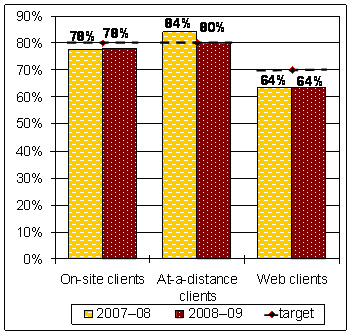
Since 2007–2008, LAC has closely monitored client satisfaction of its services through three regular internal surveys based on type of service delivery.2 The 2008–2009 results show that some 90 percent of the people using a survey tool on our website appreciate our material and would revisit the website; however, our overall Web satisfaction rates are below 70 percent, which we accept as a need to investigate. Clients dealing with us at a distance (not in-person or using the Web) rate their satisfaction slightly lower than our 80 percent target, which we believe is partly due to a backlog in responses that needs to be addressed.
Lessons Learned
The National Archival Development Program is experiencing a slight decrease in applications. We determined that the archival community is encountering application and reporting burdens that we expect to address in the revision of the NADP Terms and Conditions.
The Services Advisory Board continued to provide LAC with input from stakeholders and sister institutions that we used in designing programs and services. The success of that process reflects our commitment to provide access to decision makers and expert support people and this has guided us as we transform our services.
2 For clients who visit the LAC website, those who access certain pages are randomly selected (1 in 250) and offered an opportunity to complete a brief questionnaire. On site, clients are asked to answer a questionnaire on two days out of each month about services they received. And finally, during one week each month, all LAC responses sent to clients who had previously asked a question or requested a service include a questionnaire with a self-addressed, stamped return envelope. By these three means, completed and returned questionnaires are analyzed on a quarterly basis. Client satisfaction is defined in terms of the percentage who answer that they are "satisfied" or "very satisfied" using a five-point scale of satisfaction consistent with Common Measurement Tools used across government. Comments and suggestions provided as part of the questionnaires are analyzed to determine if further action is needed. This methodology gives LAC sound data to assess client satisfaction and improve its services.
Program Activity 1.4 – Internal Services
Internal services are "enablers" that are critically important to overall LAC strategies. The items below relate to commitments noted in Section IV of the Report on Plans and Priorities as well as other significant actions. No financial information is available for internal services alone; they are integrated into all LAC main program activities. The importance of these activities in assisting LAC to achieve institutional-wide goals merits formal representation in this report.
| Area of Major Attention: Public opinion research capacity | Performance Status: Met All |
|---|---|
| Client Research and Analysis unit was created to advise, consult, design research methodology, implement field consultations, report on findings and present to senior management Consulted with LAC clients, implemented a client research working group to review and advise on proposed research, and developed a detailed research plan, which is continuously updated |
|
| Area of Major Attention: Information technology | Performance Status: Met All |
| Client Portfolio Management organizational function created and Portfolio Management, consistent with government approach, promoted to prioritize and select IT-related projects. IT activities are better integrated with the business lines | |
| Area of Major Attention: Corporate performance | Performance Status: Mostly Met |
| Preliminary work began to strengthen LAC performance measurement through a senior management working group and LAC champion, as well as development of an action plan to improve results-based management accountability frameworks at the program activity level | |
| Area of Major Attention: Human resources | Performance Status: Mostly Met |
| Action Plan fully implemented to address issues identified in the 2005 Public Service Employment Survey for LAC Projected human resources planning training among managers was replaced in the shift to integrated business and HR planning with a template, guide and information sessions Activities identified for 2008–09 in the Employment Equity Action Plan 2007–10 were implemented to support increased workforce diversity Human resources planning integrated with business planning and a Result Management Accountability Framework was put in place as part of the commitment to improve the LAC performance measurement framework |
|
| Area of Major Attention, not included in RPP: Real property | Performance Status: Met All |
| Construction of a new Nitrate Preservation Facility approved for 2009–10 as part of LAC long-term infrastructure strategy plans for a new Collection Storage Facility is on schedule |
|
| Area of Major Attention, not included in RPP: Information management | Performance Status: Met All |
| LAC information management strategy developed and approved in line with Management Accountability Framework commitment | |
Benefits for Canadians
Effective management of internal services enables LAC to act more effectively towards the achievement of our mandate under all program activities. For example, the Client Research and Analysis unit has provided LAC with the data to better understand target markets and to fine-tune programs and service offerings to better meet the needs of Canadians. Our progress on information technology improvements means that we focus our resources on the initiatives that generate results for the Canadians wanting to explore and use our collections. We undertake these in a cost-effective manner so as to ensure the optimal use of LAC resources. Our progress on human resource issues is aligning the skills and expertise of our staff with the changing needs and expectations of the Canadians who are interested in Canada's documentary heritage. Improved corporate performance and real property activities ensure that LAC is focused on achieving the best possible results with available resources.
Performance Analysis
Internal services priorities reflected the importance of enablers to all other LAC commitments. One of the most critical was the initial set of steps in reorienting how we approach and manage information technology, away from an individual project-driven approach to one that is much more corporate and strategic in orientation. Evidence suggests this will be a longer process than first thought. In addition, LAC recognized the need to focus on an information management (IM) infrastructure. Our human resources priorities continued to address issues identified through the 2005 Public Service Employee Survey and to help achieve government-wide HR directions with a focus on reducing concerns about harassment in the workplace and integrated human resources and business planning. Client Research and Analysis responded to LAC clients by conducting qualitative and quantitative research enhancing the decision-making capacity to support LAC programs and initiatives. A research plan was developed and is continually refreshed to ensure LAC research priorities are met.
We began to address LAC's need for a stronger performance measurement framework. That process remains challenging given the difficulty of identifying appropriate data across all LAC program activities, although we anticipate that revisions to our Program Activity Architecture will help address this. Our real property commitments centred on implementing the LAC long-term strategy to put the preservation capacity in place necessary to safeguard Canada's documentary heritage and to manage vital government records. This includes a new Nitrate Preservation facility to ensure that old motion pictures and film stock are cared for in the proper environment. We also made progress on longer-term plans for a new collection storage facility.
Lessons Learned
With so many individual information technology initiatives launched over the years combined with rapid change in the IT field, we determined that more time is needed to understand what we have fully in order to guide our planning for what we want IT to become in LAC. This work is beginning in 2009–2010. Our progress on improved corporate performance management is influenced by the need to manage a culture shift from a primary focus on professional excellence in specific fields to one that also identifies and acts on a measurable institution-wide commitment to strategic results.

